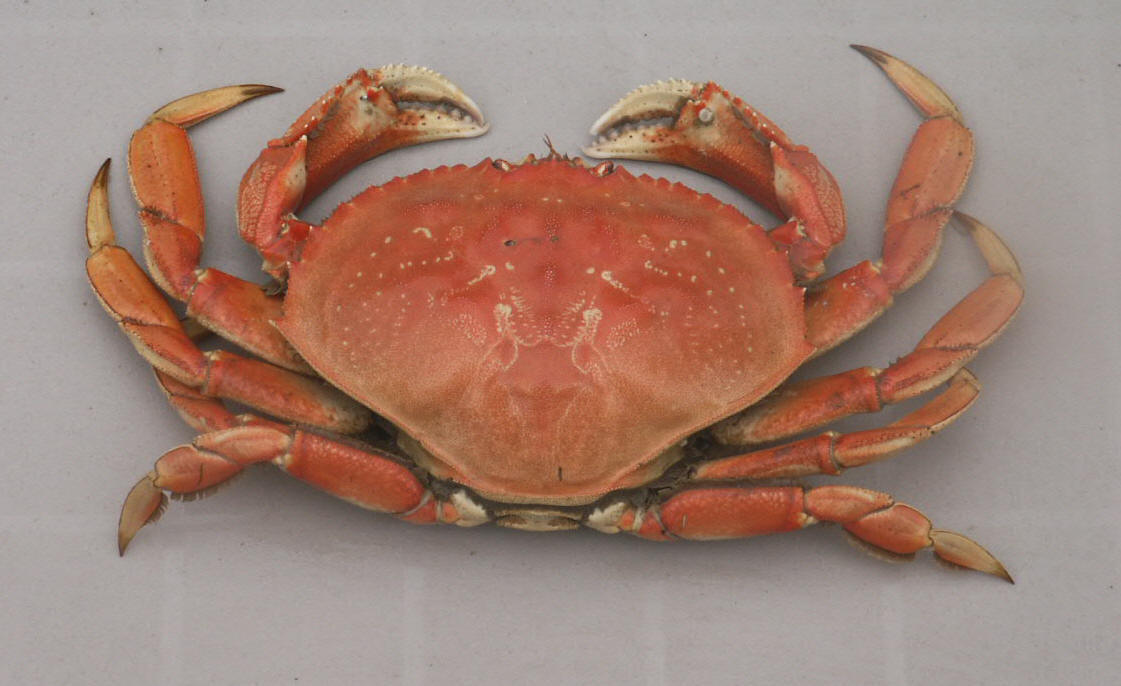SUCCESSFUL
CRABBING
The Reel News, March 2001
Darrell Ticehurst
|
 |
|
A 6 3/4" cooked Dungeness Crab |
HERE ARE A FEW TIPS TO GETTING MORE CRABS:
Square pots
with four doors catch more crabs than round ones. I’m talking about the square ones like Danielson makes. The worry with the square ones is that you
must not let them soak more than 24 hours.
If you do then they can get out because every time the door opens to let
in a crab, it creates a doorway for the ones inside to leave. And those darn crabs are pretty darn
resourceful. A little current and the
door swings and a crab leaves.
Round pots can be soaked for several days.
Square ones catch more, but they don’t hold
them as long. Round ones are much
better at keeping the crabs inside because the two entry runways are off the
floor and not affected by current or other crabs entering. If you can’t go back within 24 hours , then
round ones are the way to go.
Square pots can be improved. The doors swing open in just a small current. Attach a small weight one ounce egg sinkers on small post on
each door and they won’t swing open in the current, and the extra weight doesn’t seem to matter at all to the crabs when they enter. Drill sinker hole to fit post and crimp in place with channel locks.
Too large of a float is bad. If the float is very large it can get tossed around in a
wind. It can walk the pot right across
the bottom. Use a float that is the
right size for your pot. Talk to the
salespeople and get good advice on the float size.
Weight those pots, and the line too. To counterbalance the effect of pots
walking across the bottom from the pull of the float and line, you can put
extra weight in the pots. The square
Danielson ones are too light as they come from the manufacturer. A 4 pound lead bar is about right, but twice
that could be needed in some spots.
A cast iron window weight secured with electrical tape to bottom inside pot works fine.
One on each side is OK. Sometimes you can get a large stack at a garage sale for five bucks.
For the
line, hammer out a sheet of lead about 5 ounces and wrap a sheet around the
line every 60 feet or so. If you are
using an electric winch or other puller, make sure it will go through the
pulley, that’s why you pounded it flat.
(If you are pulling the pots by hand, then you can attach them to the
line anyway that works for you.) And if
the line is not going through your pulley properly, then use shorter lighter
lead sheets and place them closer together.
Use good bait. It’s
true that crabs are scavengers and they’ll eat anything. It’s also true that, just like you and me,
they like some things more than others.
Put your crab pot out amid a bunch of other people’s and the guy with the best bait wins. Tradition says use fish heads, fish guts,
etc. They work, but if you want to
catch more crabs use prime stuff.
Albacore and halibut filets are really good. Sweeten it up with some anchovies (chopped into thirds) and you
have prime bait. Also pretty darn good
are squid and herring combos (herring also chopped into thirds). Rockfish filets work as do rockfish
carcasses, but the best bait are the ones above. One bait that does work is salmon. But it is pretty
mediocre, not as good as the white meat
fish.
Use a bait container.
Use the containers with
slits that are made for pots, and suspend one from the top of the pot. Don’t put the bait on the bottom of the pot,
the silt collects in it and the first couple of crabs can eat it or move it
around and out of the pot. The bait
just doesn’t work as well there. And
you should fill the container about two thirds full. Leave room for a little water circulation to spread the scent
over a large an area as you can.
Don’t throw your
old bait overboard.
Pretty dumb to
throw the old bait into an area where you are putting your pots. Now you are competing with the other pots,
and your own old bait.
Put out pots in a straight line. Don’t put your pots any old way. A storm comes through or there’s a big swell
and you can’t find them. Take a reading
on your GPS when you throw out your first one, then follow a compass heading to
dump the other pots in a straight line.
They should be about 100 yards apart, or a little more. When you dump out your last pot, take
another GPS reading. Now you can find
all of your pots by just following the line you took laying them out.
Crabs move and so should you. Crabs migrate around,
and the hot spot yesterday may be dead today.
Don’t continue to put your pots in the same place, move around. And if a spot is not hot, come back to it in
a couple of weeks later to see if it has picked up.
Additional comments by LeeRoy Wisner
When dropping off a pot, check area and the tide first. If you drop off a pot in an area of no
current at LOW SLACK tide, and do not
allow a extra long amount of line. You
can come back at a higher tide & the water is really ripping, and your pot
float will not be in sight. When this
first happened to me I was sure some no-good, dirty rotten, pot snatching, SOB
had done his job. No, it was just me,
and not being observant. I came back
the next week-end & recovered the pot.
They say that good judgment comes from the experience of bad judgment.
Remember when crabbing the ocean you want to be in at least 65 or 70 feet of water if you return in adverse conditions your gear is not in the surf and can be picked up without danger.
Be sure to use bait boxes to keep them fishing all day.
The law says you will have your line weighted. The reason is that if it is not, then at a
slack tide most nylon/plastic lines will float near your float. This can cause problems with other boaters
getting it around their props. Many
crabbers use the snap on line weights. In use, throw out your pot, & let
out your line, when the pot hits the bottom, snap a weight on then. Some simply wrap 1/4" lead sinker wire around
the line. If you are using a long line, you may have
to put another weight on before you get to the float. One thing I do is to make all my lines in increments of 50 feet,
and connect then with a stainless snap.
This way I can adjust how much line I need for each pot in any given
water depth.
Another thing you can try is to put some Smelly Jelly, or
other scent on your bait box. Smell Jelly makes a crab bait scent.
A couple more that was passed on by a RV park owner at
Westport. Take an empty soda can & put a couple of small rocks in it, punch
a hole in it so you can tie it inside the pot. It is supposed to make a
rattling noise that attracts crab. Then if you put a steel or cast iron
weight in the bottom of the pot, but let it set out & rust. You
may also consider placing an old zinc annode
off your boat or motor on the pot's metal weight. If the right combination of metals, there can
be electrolysis, which is in reality a small electrical charge that may repel
the crabs.



